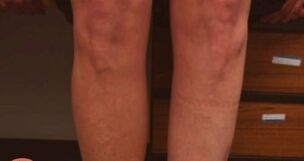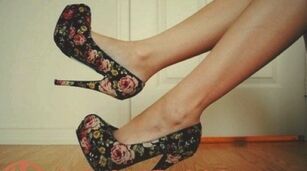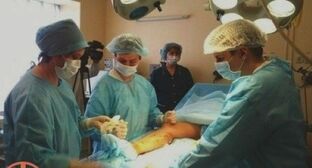Varicose veins are a common pathological process that is accompanied by varicose veins and blood stagnation. The internal varicose veins on the legs are characterized by the nodular structure of the venous vessel of the epidermis. There are no symptoms in the early stages of the disease. Many people are wondering what to treat for this disease.
What is this disease?

Varicose veins in the lower extremities are a very dangerous disease that can be fatal. It is an abnormal change in the organs of the circulatory system. With the complication of the disease, an irreversible process of vein stretching and stretching is observed.
Lumps begin to form in the capillaries that impede normal blood flow. With deep vein varicose veins, the walls of the vessels dilate so much that the function of the valves deteriorates. Because of this, the blood begins to stagnate in the legs.The disease mainly affects people between the ages of 30 and 40.
Reasons for improvement
The causes of this disease can be very different. These include:
- hereditary factors (possible congenital abnormality or weakness of venous cells);
- is more common in women (the disease is much more common in women due to the use of hormonal drugs, the risk also increases due to delayed childbirth);
- increased pressure in the veins (due to an inactive lifestyle in the presence of being overweight);
- the presence of neuroendocrine changes; mechanical obstructions to normal blood circulation (this may be facilitated by constant compression of the limbs);
- presence of allergic reactions;
- changes in the immune system;
- disorders of the valves of the venous system;
- this pathology may be due to cellulite or dermatitis.
It is important to determine the cause of the disease before starting treatment. An experienced phlebologist will help you with this.
Internal Varicose Veins Symptoms and Manifestations
It is important to see a doctor in timeif varicose veins in the lower extremities appear. The symptoms of this disease during the development of the varicose veins will be as follows:

- swelling of the limbs by the end of the day(this symptom is seen on the ankles and feet, edema may also appear in the lower half of the lower leg);
- the patient's feeling of heaviness develops in the calf muscles(the feeling of bloating occurs after a long walk or standing position, it can occur after a long sitting position).
A characteristic feature of this disease is that afterrest, all symptoms disappear without a trace.Shrinks even after a long rest.
During the period of gradual development of the varicose veins, the following symptoms begin to appear:
- moderate pain begins to appear in the area of the calf muscles, such pains are dull and sore;
- local burning sensation and fatigue;
- excessive dryness of the skin appears, pigment spots and calluses appear;
- cramps very often at night;
- spider veins begin to appear on the epidermis;
- the internal blood vessels on the legs, photographs of which are shown below, begin to dilate considerably, appearing as bunches of grapes;
- fine wounds can be formed that heal for a long time.
Important!Premature treatment of the disease can bring a number of complications for the patient. In some cases, a fatal outcome is possible.

After a while, eczema and trophic ulcers begin to appear. Such symptoms very easily become gangrene. All of this can cause limb amputation, sepsis, or death.
The most dangerous consequence is the occurrence of a blood clot with subsequent weaning. This becomes the death of the patient.
Latent varicose symptoms and treatment is the issue that concerns patients the most.
Treatment Methods
Treatment of varicose veins is conservative and fast. Treatment of internal veins in the legs, the symptoms of which may occur in different ways, is performed only after a preliminary diagnosis. The following techniques can be used:
- compression;
- scleropathy;
- medication;
- surgical.
compression methodscures help cope with the disease in its initial stages. This method of therapy involves the daily wearing of special compression underwear.
In scleropathy, the vein becomes blocked. This is due to the introduction of sclero preparations. After such actions, the blood can move easily and without difficulty on the capillaries.
Conservative treatment is only effective if the first signs of the disease appear. Among the drugs, venotonics are prescribed to patients. They contribute as much as possible to strengthening the walls of blood vessels.
Self-treatment of internal varicose veins with mild symptoms and vice versa is prohibited.
Prevention
In order to prevent the development of varicose veins, it is essential to know the causes of this disease and prevent them from developing.Preventive measures include:
- Constant physical activity is needed (People who lead an inactive lifestyle are much more susceptible to disease. There is no need to exhaust yourself with exercises and avoid overwork. We just need to do light exercise. It is important to avoid lifting heavy objects. When sitting, it is necessary to take a break from time to time, get up and exercise to keep the blood circulating normally. );
- It is forbidden to cross your legs while sitting;
- give up all bad habits;
- pay attention to your diet, reject too fatty and salty;
- lead to the development of therapeutic measures in relation to endocrine diseases;
- Use only loose, non-squeezing shoes (ensure free blood flow and restrain yourself in heels);
- take a sea bath, but you need to stop the sun from overheating.
Conclusion
It should be noted that if at least one symptom of this disease occurs, a specialist should be consulted urgently. Your doctor will prescribe diagnostic procedures and indicate appropriate treatment. Delay threatens complications.
From the above, we can conclude that the latent varicose vein is a very dangerous disease that can have undesirable consequences. Therefore, if at least one symptom appears, a doctor should be consulted. Only a specialist can select the treatment you need.
Internal varicose veins in the legs: symptoms and treatment
The geography of varicose veins extends to almost every country in the world, it is one of the oldest diseases known to mankind. According to medical statistics, varicose veins of the lower extremities and pelvic organs occur in 15-17% of the population. Today, patients with such a diagnosis make up about 4% of patients in surgical clinics. Scientists say this disease is a kind of payment to humanity for the ability to walk straight. Examine what the internal varicose veins are, the main symptoms of the disease and effective treatment.
Explaining the appearance of the disease
The development of internal varicose veins in the legs is one of the most dangerous types of disease, manifested by abnormal dilation of blood vessels located deep in the tissues of the skin.
Unfortunately, this disease often affects young people of working age, and the symptoms are much more common in women. The internal varicose veins on the legs are often accompanied by an external one in the form of strongly protruding tuberous veins with a pronounced bluish tinge.
These symptoms of varicose veins make treatment difficult. The appearance of varicose-node legs is illustrated by a number of photographs of medical sites.
Dilation of venous blood vessels in the legs may be a pathology in its own right, but it is most often caused by other diseases, so in modern medicine it is customary to divide varicose veins into primary and secondary. The primary cause of varicose veins in the deep veins of the legs is the weakness of the venous wall or its functional diseases, these causes also cause varicose veins of the pelvic organs. The main causes of the disease are:
- Pregnancy.
- Overweight, pathological obesity.
- Constant load on the lower limbs, constant work on the legs, or constant heavy lifting.
- Hereditary or congenital weakness of the connective tissue of various organs.
- Wearing a long walk in high heels and stockings with tight elastic straps.
- In elderly patients, the development of the internal vein can be caused by hormonal changes in the body.

Secondary varicose vein formation is a consequence of changes in the process of venous blood outflow in various diseases:
- Postthrombophlebic syndrome.
- Deep venous valve failure.
- Tumors of organs of different etiologies.
- Injuries to limbs and other organs.
The treatment of the primary and secondary varicose veins is different.
Key Features
The consequences of an undetected internal varicose vein can be very severe, so attention should be paid to the very first symptoms of the disease, especially because they are very clear visually compared to other forms of the disease. The main symptoms of internal varicose veins in the lower extremities are as follows:
- Calf muscle pain is very severe, often so unbearable that the patient is forced to take strong painkillers on a regular basis. These symptoms are the cause of immediate medical attention.
- The venous pattern of the lower limbs in the thigh area becomes accentuated, the blood vessels become strongly convex and tuberous, and can be easily identified by touch.
- The venous pattern takes on a cyanotic color, sometimes turning black, sometimes purple-red.
- The lower extremities are very swollen and the swelling does not decrease after a night's sleep.
- In the evening, after a working day on his feet, the patient experiences frequent cramps in the calf muscles.
All of these symptoms significantly impair a patient’s quality of life and require immediate medical attention, sometimes just surgical treatment of the veins.

Clinical presentation
The severity of internal varicose vein symptoms depends on the stage of the disease.
In the initial stage, no abnormalities in the walls of the blood vessels are detected, the patients swell their legs by the end of the working day and the legs are heavy, but after a night’s rest, these unpleasant feelings disappear.
Some patients have a mild paste, this stage of the disease is called "intradermal varicose veins". If treatment is started at this stage of the disease, the prognosis is very favorable, as the valve system of the veins has not yet changed and copes with the load, the pathological symptoms disappear quickly.
In the second stage of the disease, the edema of the lower extremities becomes permanent, with patients complaining of constant leg heaviness and increased fatigue. Manifestations of the internal varicose vein at this stage of the disease are also indicated by constant spasms of the calf muscles and limbs.
A photo from medical publications shows that blood vessels begin to appear on the skin on the inside of the thigh, but the zones of their appearance are not painful to the touch. At this stage, the varicose veins begin to form and there may be bleeding from them.
These symptoms worsen very quickly, and if there is no treatment, the disease progresses to the next stage.
The third stage of leg varicose veins is already well delineated visually, as can be seen in the photo from various medical sources.
Varicose veins and saccular enlargements caused by severe circulatory disorders are now well defined under the inner skin of calves and thighs.
At this stage, in addition to the appearance of nodules, the patient has fragility and hair loss, dry skin, and constant cramps in the calf muscles.
The fourth stage of the disease is already associated with serious complications (bleeding, ulcers, etc. ) that can be fatal. You should start treating the disease right away without waiting for scary symptoms.
Complications
These are:
Trophic ulcers of the skin of the foot.
This is a very painful complication for the patient as trophic ulcers heal very slowly and the patient experiences constant itching and burning at the site of their localization.
The photo clearly shows that the ulcers are round in shape, brightly colored, and have different types of secretion: purulent, hemorrhagic, or serous secretions. They appear on calves and on the inside of the thigh.
With competent and timely therapy, ulcer scarring begins, but if left untreated or inadequately provided, gangrene can develop in the patient, followed by limb amputation. Death is also possible.
Traumatic bleeding.
Massive bleeding can be caused by a rupture of a blood vessel due to a thinning of the venous wall due to ever-increasing blood pressure or minor trauma. This syndrome is particularly dangerous because bleeding can lead to the death of the patient.
Thrombosis is the result of congestion and inflammation of the veins in the lower limb. Thrombosis can only visually occur in the form of swelling of the foot and severe pain in it.
With the formation of external venous nodes, thrombosis is associated with severe pain in the area of thrombus formation, sensitivity of the veins to the touch, and fever in the area of thrombosis.
Thrombosis is very life-threatening and requires urgent hospitalization and treatment as it can cause heart attack and pulmonary artery occlusion in the patient.

Principles of Therapy
It is very difficult to treat the internal varicose veins in the legs, and the effectiveness of the therapy depends largely on the stage of the disease.
General principles of disease management are normalization of hormonal levels, optimization of physical activity, and adherence to diet.
If the patient is obese, a weight loss method should be developed and its implementation monitored. It is recommended to use compression stockings to normalize the tone of the vessels of the lower limbs.
The most effective method of treatment is surgery, the technique of which is well developed in modern surgery. Bleeding from a vein is a possible complication of surgery, but the risk is low.
If, for any reason, surgery is not possible, for example, if the patient fears that life-threatening bleeding will begin, treatment will be given with the following groups of medicines:
- Antiplatelet agents - to dilute the blood and prevent blood clots.
- Phlebotonics - to normalize blood circulation and prevent edema.
- Nitrates - to relieve the symptoms of pain.
- Angioprotectors - to normalize vascular tone.
- Non-steroidal anti-inflammatory drugs - to reduce platelet adhesion and relieve pain.
Many sources recommend treating varicose veins with folk remedies, there are many photos of calves and thighs on the internet in “before” and “after” styles on pages that advertise traditional medicine and guarantee 100% recovery. Doctors are very wary of such drugs and warn that they should only be used as part of a complex therapy.
Internal varicose veins in the lower extremities are a severe systemic disease that requires timely and professional treatment. The first alarm symptoms cannot be ignored. The sooner the patient sees a doctor, the more effective the treatment will be.
Main characteristic symptoms
Specialists distinguish three stages of lower limb varicose veins - compensation, subcompensation, and decompensation.
Respectively for light, medium and severe runoff. In some cases, more than a year elapses between the onset of the disease and the onset of symptoms.
There's virtually nothing to worry about when it comes to compensation. There may be less pain in the limbs during severe body tension. Distal swelling that subsides after sleep.
Some people feel like spiders or goosebumps are sliding along their legs. This is a consequence of harmful blood flow and tissue trophism.
The deep vein valve device is largely intact. Visible surface changes in the skin and veins are usually not observed.
Subcompensation is characterized by a more severe clinical picture. Pain is becoming more common. They wear sharp dagger pain. Casual touch can be quite hard work.
Patients cannot walk normally. The usual shopping path is debugged to the last.
The legs are greatly swollen, one and a half times the normal volume of the foot. Often, such swelling does not go away even after prolonged sleep. Traces of depressed toes remain on the leg. Many people notice cramps in the calf muscles.
During decompensation, there are often signs of bleeding, thrombophlebitis and thrombosis, trophic ulcers.
Complications of internal varicose veins
The most common complication of varicose veins is bleeding. If not diagnosed in time, it can be fatal. Even minor bleeding from the varicose veins in the lower extremities can cause irreparable damage. Eliminating such a fault with conventional compression bonding often fails. Many surgeons come to ligate or coagulate blood vessels.
The second most common complication is the addition of infections with the development of trophic ulcers. Due to the decrease in tissue trophism, the abscesses do not heal for a long time, a chronic purulent focus is formed.
General body poisoning, feverish temperature, heavy sweating. It takes a very long time for such wounds to heal. This depends on the degree of disruption of the tissue trophism and the depth of the lesion.
Ulcers should not be bandaged frequently as this can cause crusts that have begun to form and lead to the re-formation of an open wound.
The next most common complication is deep vein thrombosis. With poor motor function, the blood stagnates and the risk of blood clots increases, which in turn can cause pulmonary embolism.
Vascular surgeons are more afraid of the floating thrombus because its distal part tends to rupture and lead to embolism.
Treatment Methods
Treatment of internal varicose veins in the lower extremities takes place in several stages.
Drug therapy is the most popular direction that can be used at all stages of the varicose veins as well as in the prevention of vascular problems.
Conservative treatment is based on the administration of venotonic drugs. They help strengthen the blood vessel wall, increase its elasticity and reduce blood stagnation. It is better to apply both internally and externally at the site of the lesion.
There are several classes of underwear that are used in different stages of the disease. A lot of models are able to satisfy the individual desires of each person, I only have positive opinions.
Do not cause discomfort or irritation when wearing under clothing.
Proper and balanced nutrition is one of the important points in the treatment of varicose veins in the lower extremities. Consumption of salt and large amounts of fluid should be radically limited. It is desirable to use natural fruit drinks and juices.
Thediet should strictly match human energy intake and contain fewer calories to avoid being overweight. You should limit the consumption of fatty and fried foods, spicy and sour. You should give preference to vegetables and fruits. Include products in your diet that include seafood, fermented dairy foods, and digestible carbohydrates.
Conservative techniques are resorted to when surgical techniques are ineffective. These include both invasive and minimally invasive treatments.
Prevention of pathology
Knowing how dangerous deep vein varicose veins are, many people want to prevent them from happening in advance. To do this, you don’t have to follow strict rules, you just have to get your lifestyle back to normal.
The main preventive measure is regular physical activity.
You can exercise, yoga, walk, swim or even dance to reduce your risk of many diseases.
In addition, it is advisable to give up bad habits in whole or in part. We recommend regulating your work and rest schedule in order to give your body at least a short break.
It would be helpful to change your diet, except for fried, fatty, smoked, pickled, overly spicy or salty foods. You need to eat more vegetables and fruits.
Regular contrast showers and relaxing foot baths are good preventative measures.












































